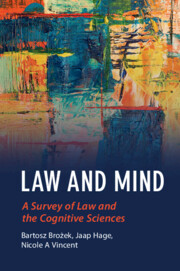Book contents
- Law and Mind
- Law and the Cognitive Sciences
- Law and Mind
- Copyright page
- Contents
- Figures
- Contributors
- Acknowledgements
- 1 Introduction
- I Metatheory and Methodology
- II Ontology and Epistemology
- III Legal Doctrine and Cognitive Sciences
- 11 Private Law and Cognitive Science
- 12 Private Law and Cognitive Science: A Methodological Commentary
- 13 Responsibility, Liability, and Retribution
- 14 Guilt in Criminal Law: Guilt in Us or in the Stars?
- 15 The Insanity Defense
- 16 Thoughts on the Insanity Defence
- IV Evidence
- V Dissenting Opinions
- References
16 - Thoughts on the Insanity Defence
from III - Legal Doctrine and Cognitive Sciences
Published online by Cambridge University Press: 21 April 2021
- Law and Mind
- Law and the Cognitive Sciences
- Law and Mind
- Copyright page
- Contents
- Figures
- Contributors
- Acknowledgements
- 1 Introduction
- I Metatheory and Methodology
- II Ontology and Epistemology
- III Legal Doctrine and Cognitive Sciences
- 11 Private Law and Cognitive Science
- 12 Private Law and Cognitive Science: A Methodological Commentary
- 13 Responsibility, Liability, and Retribution
- 14 Guilt in Criminal Law: Guilt in Us or in the Stars?
- 15 The Insanity Defense
- 16 Thoughts on the Insanity Defence
- IV Evidence
- V Dissenting Opinions
- References
Summary
The comments by Claydon and Catley on the contribution of Meynen about the insanity defence concentrate on the attributions the law makes concerning responsibility, and consider the basis of insanity in Anglo-American jurisprudence. Over time, definitions of legal insanity have developed to reflect changes in medical understading and societal attitudes to mental health.
The starting point is taken in the legal definition of insanity and in Anglo-American understandings of this law with its foundation in M’Naghten’s Case. The M’Naghten Rules are not set out in case law, but arose through the questioning of the puisne judges by Parliament. The judges were asked to justify their decision to find M’Naghten insane. These circumstances highlight that from the beginning the insanity defence was politically charged. Thus the rules are, in a sense, a defensive response to the question posed by the legislature as to why Daniel M’Naghten deserved to be excused criminal liability.
Having considered the structure of the insanity defence and its development and review post M’Naghten, the authors look at the question of the burden and threshold of proof, before concluding by addressing two relevant questions. Firstly, why would anyone think that neuroscience would provide a total answer to questions of criminal responsibility in cases of legal insanity? Secondly, why would anyone think that neuroscience would not be relevant to deliberations concerning criminal insanity?
- Type
- Chapter
- Information
- Law and MindA Survey of Law and the Cognitive Sciences, pp. 342 - 350Publisher: Cambridge University PressPrint publication year: 2021



